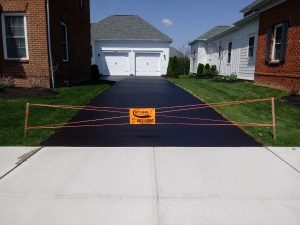Enhance Sturdiness: Hot Mix Asphalt Sealing for Angled Parking Frameworks
Enhance Sturdiness: Hot Mix Asphalt Sealing for Angled Parking Frameworks
Blog Article
Hot Mix Asphalt: A Lasting Option for Sidewalk
Hot Mix Asphalt (HMA) has actually arised as a leading lasting selection for pavement options, providing a myriad of environmental benefits and ingenious innovations. As the need for green building and construction methods expands, checking out the nuances of HMA's sustainability can supply important understandings into the future of sidewalk options.
Environmental Advantages of Hot Mix Asphalt

Additionally, Warm Mix Asphalt helps to minimize metropolitan warmth island impacts. Its dark shade soaks up sunshine, lowering the amount of warmth reflected back right into the atmosphere compared to lighter-colored pavements. This can reduce ambient temperature levels in metropolitan locations, reducing the demand for air conditioning and inevitably decreasing power usage.
On top of that, Hot Mix Asphalt adds to enhanced stormwater monitoring. Its permeable nature allows water to infiltrate the sidewalk and reenergize groundwater materials, minimizing drainage and the threat of flooding. These environmental advantages make Warm Mix Asphalt a sustainable selection for leading freeways and roads.
Energy Efficiency in HMA Manufacturing
Is energy efficiency a critical aspect in the production of Hot Mix Asphalt (HMA)? Definitely. Power plays a substantial role in the manufacturing of HMA, influencing both cost and ecological sustainability. One crucial element of energy performance in HMA production is using warm mix asphalt (WMA) innovations (hot mix asphalt). WMA permits the blending and positioning of asphalt at reduced temperature levels compared to standard warm mix asphalt, resulting in lowered energy consumption throughout production. This procedure not just decreases gas usage yet likewise lowers greenhouse gas discharges, making it a more environmentally friendly choice.
Additionally, advancements in plant innovations have actually led to even more energy-efficient HMA manufacturing processes. By optimizing power use in HMA manufacturing, the industry can minimize its carbon footprint while keeping high-grade pavement materials.
Recyclability of Warm Mix Asphalt
The recyclability of Warm Mix Asphalt (HMA) is a pivotal facet of its sustainability and long-term environmental influence. HMA is one of one of the most recycled products in the United States, with over 100 million lots of reclaimed asphalt sidewalk (RAP) being reused each year in new pavement construction. Reusing HMA provides numerous environmental advantages, such as decreasing the demand for virgin products, reducing energy usage during production, and lowering the amount of waste sent to land fills.
The procedure of reusing HMA entails milling the existing sidewalk, crushing it right into smaller sized items, and mixing it with brand-new aggregate and asphalt binder to develop a recycled mix. This recycled mix can usually carry out as well as or also better than traditional HMA, while requiring less raw products and generating reduced greenhouse gas emissions. By incorporating RAP into new sidewalk jobs, roadway firms can conserve natural deposits, lower expenses, and reduce the ecological footprint of roadway building and upkeep tasks. In general, the recyclability of HMA plays a substantial function in promoting sustainable techniques within the pavement market.

Long-Term Performance of HMA
Asphalt pavements show resilience and durability over an extensive period, reflecting the lasting efficiency of Hot Mix discover here Asphalt (HMA) In addition, developments in HMA technology, such as the use of polymer-modified binders and cozy mix asphalt, have actually even more improved the sturdiness and long life of HMA pavements. By prioritizing high quality building and upkeep techniques, HMA proceeds to verify itself as a sustainable and great post to read cost-effective option for resilient sidewalk framework.

HMA: Toughness and Sustainability
Showing both resilience and sustainability, Warm Mix Asphalt (HMA) has become a keystone in the building of long-lasting sidewalk facilities - hot mix asphalt. HMA's sturdiness originates from its ability to endure hefty loads, extreme weather, and high traffic volumes, making it a trusted option for roadways, freeways, and flight terminal runways. The composition of HMA, which generally includes aggregates, binder, and filler, plays a vital role in boosting its long life and resistance to wear and tear
In addition, HMA's sustainability hinges on its recyclability and energy-efficient manufacturing process. The capacity to recycle recovered asphalt sidewalk (RAP) in brand-new HMA mixes minimizes the need for virgin products and decreases the ecological influence of sidewalk building and construction and upkeep. In addition, the energy effectiveness of creating HMA depends on its reduced mixing temperatures contrasted to other pavement products, causing lowered power usage and greenhouse gas discharges.
Conclusion
In conclusion, warm mix asphalt (HMA) offers a sustainable remedy for pavement with its ecologically friendly qualities. HMA's recyclability, power effectiveness in production, and useful reference lasting resilience make it an environment-friendly choice for road construction.
HMA is one of the most recycled products in the United States, with over 100 million heaps of reclaimed asphalt pavement (RAP) being reused annually in new pavement building and construction.The procedure of recycling HMA entails crushing the existing sidewalk, squashing it into smaller items, and blending it with new aggregate and asphalt binder to create a recycled mix.Asphalt pavements demonstrate durability and strength over a prolonged period, reflecting the long-lasting performance of Hot Mix Asphalt (HMA) Additionally, advancements in HMA technology, such as the use of polymer-modified binders and cozy mix asphalt, have actually better improved the toughness and longevity of HMA sidewalks. The ability to reuse recovered asphalt sidewalk (RAP) in brand-new HMA mixtures reduces the need for virgin materials and reduces the ecological impact of sidewalk building and upkeep.
Report this page